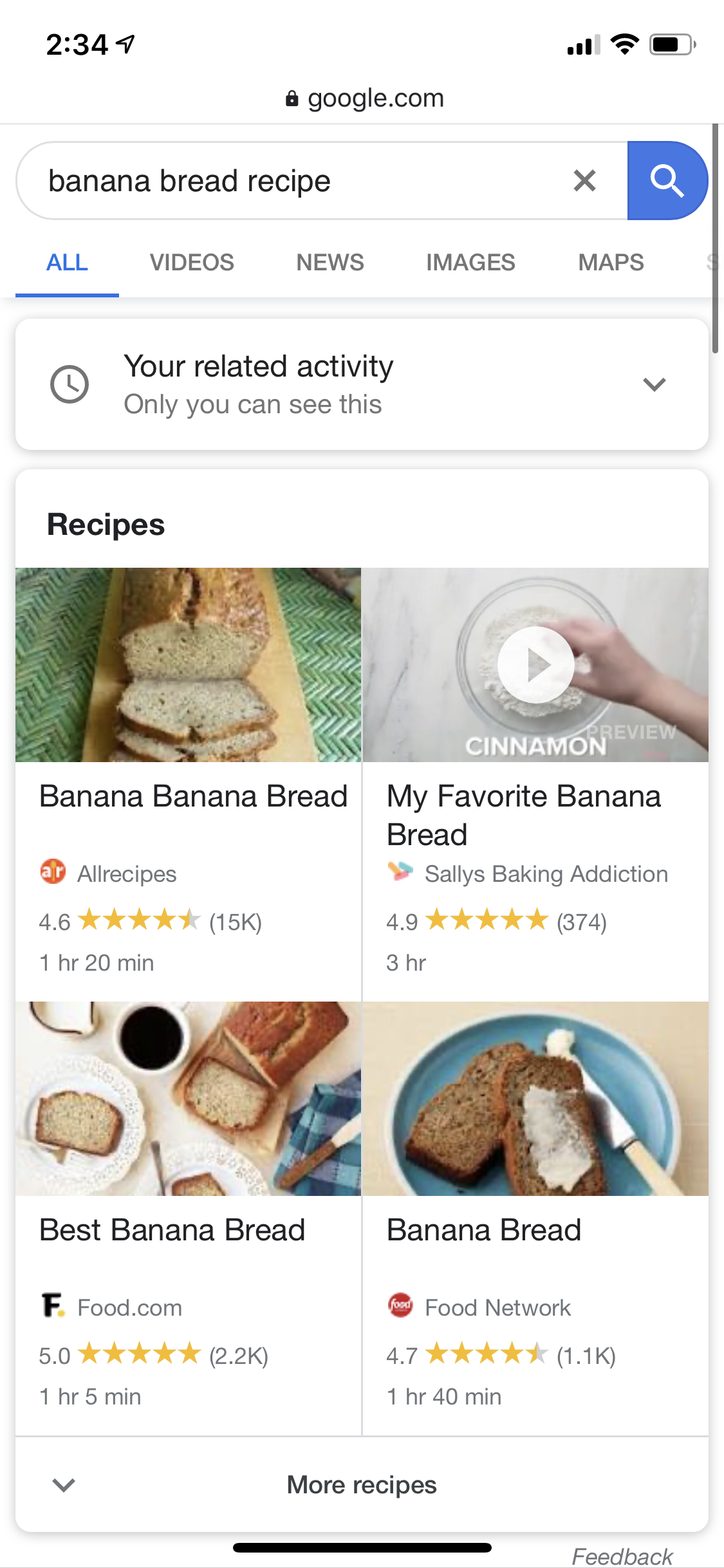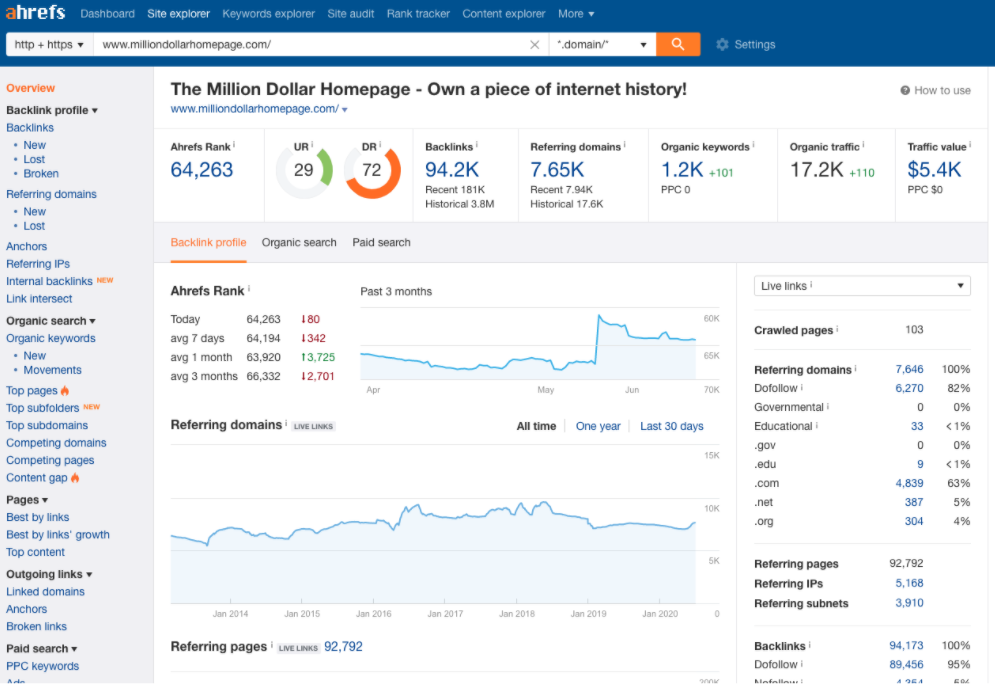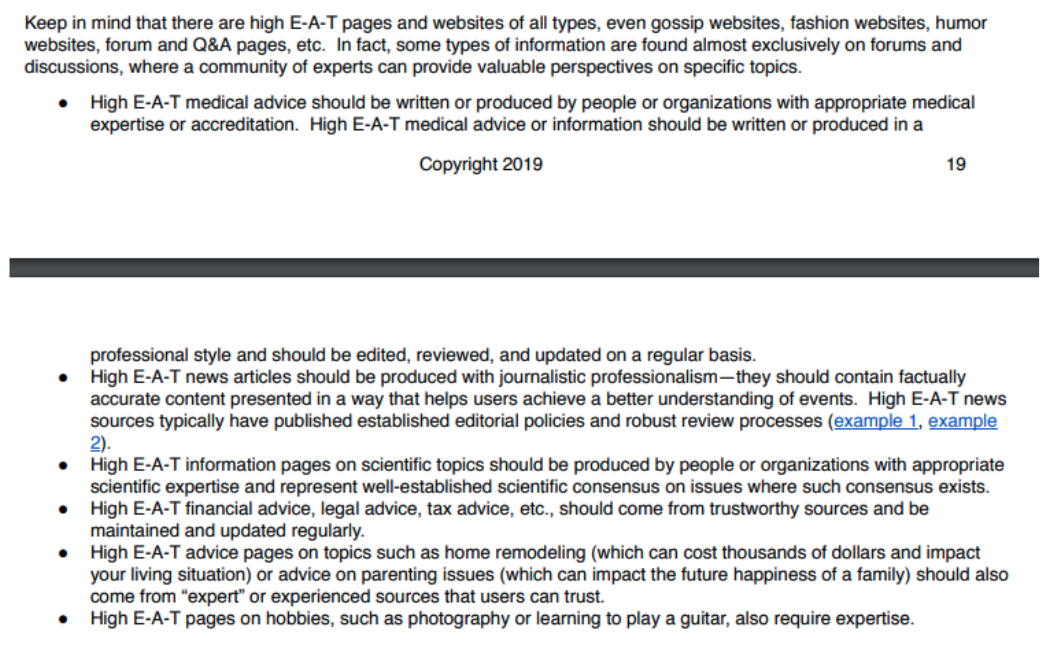E-A-T has been a hot topic when it comes to on-site content.
But why, how, and when should you consider concepts in E-A-T with link building efforts?
Your site cannot have E-A-T without a link and brand mention profile.
In the Search Quality Rater Guidelines, Google states that “sources of reputation” are “news articles, Wikipedia, articles, blog posts, magazine articles, forum discussions, and ratings” when establishing Page Rating.
And it’s easy to determine that E-A-T can, in certain niches and to varying degrees, be leveraged in evaluating a site’s fit to secure a link.
But, Google’s Ben Gomes said in a 2018 interview with CNBC that:
“You can view the rater guidelines as where we want the search algorithm to go.”
“They don’t tell you how the algorithm is ranking results, but they fundamentally show what the algorithm should do.”
Even though E-A-T doesn’t directly have an impact on ranking, it can result in creating signals that drive direct ranking improvement.
ADVERTISEMENT
CONTINUE READING BELOW
Still, it’s important to use your own experience when understanding what works and doesn’t work in your niche.
If you follow Google’s recommendations or guidelines strictly, you’ll always be playing the long-game or even lack any results, when it comes to link building.
And it’s clear that Google cannot even implement an algorithmic interpretation that has the strictest interpretations of these guidelines.
A great example of this is under recipes.
My eight-year-old daughter and I were looking for banana bread recipes in Google.
We found the one in the screenshot below from Allrecipes.
I found that this recipe is actually way off on the bake when we baked it, by more than 30 minutes. But it had more than 15K reviews.

I can dig up a hundred similar examples fairly easily.
ADVERTISEMENT
CONTINUE READING BELOW
So there is a major caveat when applying my interpretation of E-A-T to guide link acquisition.
Don’t use E-A-T guidelines to strictly evaluate prospective sites in every niche.
When to Use E-A-T Standards for Link Prospects?
There are three major considerations before even bothering to review a site against your guidelines, under a fair interpretation of Google’s search quality raters guidelines.
- If the sites are completely useless, then no need to do an in-depth analysis.
- Not every niche or scenario requires a strict analysis of a site to build a link.
- A natural link profile doesn’t just have E-A-T sites.
Let’s start with a “useless site,” as there is no point in further review of a site if it is not designed to create value but is “made for SEO.”
Google’s page quality guidelines state that:
“Websites or pages without any beneficial purpose, including pages that are created with no attempt to help users, or pages that potentially spread hate, cause harm, or misinform or deceive users, should receive the Lowest rating. No further assessment is necessary.”
I do not believe in having a strict interpretation of the phrase “beneficial purpose.”
My interpretation is that if the site has no relevant content that helps users then it’s useless.
But it isn’t so clear.
For example, The Million Dollar Homepage had no value but to sell ads so a guy could make a million dollars by selling ads.

This site has over 94,000 backlinks (Ahrefs) but only ranks for 1,200 keywords.
This is an extreme example of a site I’d just avoid.

As for point 2, there are certain niches that require much stricter review than others.
ADVERTISEMENT
CONTINUE READING BELOW
YMYL sites have much stricter standards than other niches.
In the guidelines, Google provides some guidance on what constitutes a completely useless site.
In the guidelines, Google explains that YMYL vs other sources will have different sources of reputation.

The last point is just a reality check for you people that review your link profile, or even build disavow lists with a strict interpretation of what is “high” or “low” quality.
If you’ve analyzed backlink profiles for competitive niches, then you’ve certainly seen a mix of links that you may consider verily degrees of quality and with a wide metric variation.
The screenshot from Ahrefs shows that bestcolleges.com’s page that ranks for “best online colleges for psychology” has a mix of link quality and domain rating (DR).
ADVERTISEMENT
CONTINUE READING BELOW
There are certainly many lurking and confounding variables that also have an impact, but it’s so commonplace that you cannot ignore this fact.

What Are the Criteria for Evaluation?
My team and I have built a score with over 50 variables we delivered called PureGrade, to understand the likelihood of the site having a positive, negative, or neutral impact based on main content (MC) and supplemental content.
That said, Google uses an interesting scale that, in my opinion, provides way too much freedom to raters.
My team has used these criteria to rank sites that don’t necessarily qualify for YMYL content.
This has been built based on a manual review of over 60,000 sites and thousands of pages, across hundreds of enterprise-level projects.
And, Moz’s spam score has over “27 common features” that they claim correlates with a significant amount of banned or penalized sites.
ADVERTISEMENT
CONTINUE READING BELOW
I don’t recommend using Moz’s spam score, PureGrade, or other single metrics as gospel for disavowing or prospecting new sites.
However, it helps to illustrate the point that we need to evaluate sites against a set of criteria and not only one or two.
Google guides its raters to use a scale of lowest, lowest+, high+, high, medium+, medium, low+, lowest +, and lowest.

It’s really important to note that this scale is used to rate the ranking site and not the linking site. This doesn’t mean you can’t use this scale to evaluate prospects.
For the purposes of this article, which is to make a connection between the quality rater guidelines and link-prospecting review criteria, I’ll only be listing out elements of a site based on E-A-T from ideally what Google’s, or search engines, “algorithm should do,” and not what I’ve seen work to drive ranking improvements.
ADVERTISEMENT
CONTINUE READING BELOW
The rater guidelines only press on the idea of finding an expert in the niche and verifying that they are experts.
These core elements to review are:
- About us, contact, or customer service info.
- Outbound link profile.
- A “positive reputation” of the main or supplemental content.
Beyond just finding the authorship, it’s important to evaluate the MC pages, and one key indicator is whether the site mentions “buy dofollow links” anywhere on the site.
If the site does say this, then it’s likely that most of the articles are not from reputable sources and you should avoid it.
This is not the case when the site mentions “paid guest posting.” This can mean they offer sponsored posts or affiliate links.
This is just how sites make money, and can be separate from the main content.
With an outbound link profile, search for overly commercial links.
These are typically links that surprise the user when clicked by funneling the user to the homepage or transactional pages.
ADVERTISEMENT
CONTINUE READING BELOW
Finally, the “positive reputation,” is much harder to establish.
Use a mix of metrics from Ahrefs, Majestic, and Moz to understand the site reputation profile.
But you can also use tools like BuzzSumo to identify if the articles of the prospect get shared or have engagement.
A Final Note
It’s really important to note from the rater guidelines that:
“Frequently, you will find little or no information about the reputation of a website for a small organization. This is not indicative of positive or negative reputation. Many small, local businesses or community organizations have a small “web presence” and rely on word of mouth, not online reviews. For these smaller businesses and organizations, lack of reputation should not be considered an indication of low page quality.”
When evaluating micro-influencers or small blogs for prospects, you have to realize it’s not always critical to be strict.
More Resources:
ADVERTISEMENT
CONTINUE READING BELOW
Image Credits
In-Post Image: Created by author, June 2020
All screenshots taken by author, June 2020
"eat" - Google News
July 02, 2020 at 09:13PM
https://ift.tt/2VIXtOy
E-A-T & Link Building: A Guide to Evaluating Prospects - Search Engine Journal
"eat" - Google News
https://ift.tt/33WjFpI
https://ift.tt/2VWmZ3q
Bagikan Berita Ini














0 Response to "E-A-T & Link Building: A Guide to Evaluating Prospects - Search Engine Journal"
Post a Comment